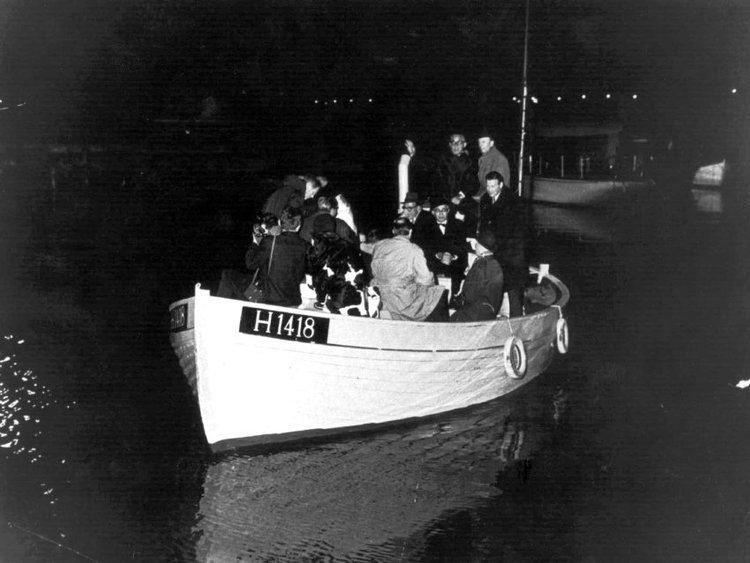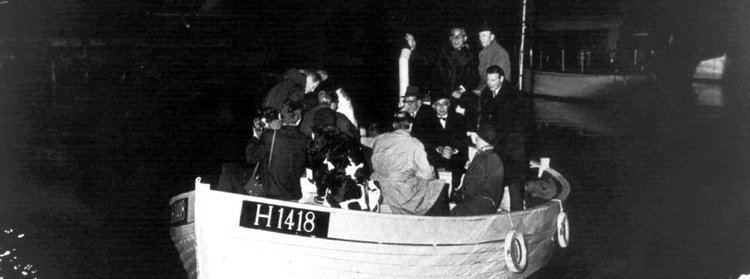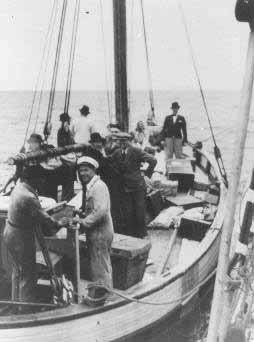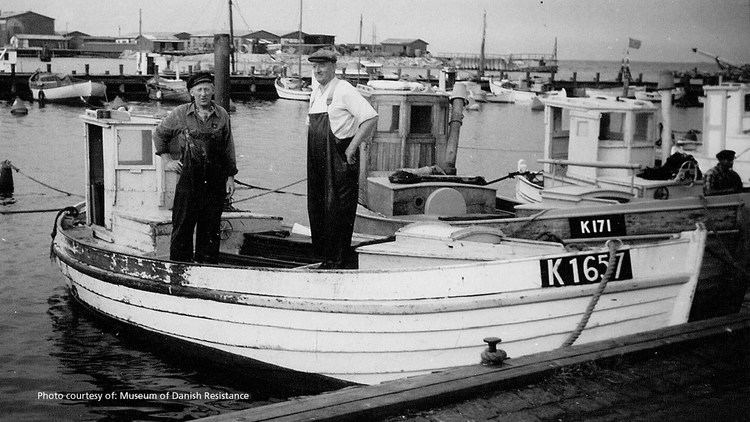Start date October 1, 1943 | ||
 | ||
Rescue of the danish jews 1943
The rescue of the Danish Jews occurred during Nazi Germany's occupation of Denmark during World War II. On October 1, 1943, Nazi leader Adolf Hitler ordered Danish Jews to be arrested and deported. Despite great personal risk, the Danish resistance movement, with the assistance of many ordinary Danish citizens, managed to evacuate 7,220 of Denmark's 7,800 Jews, plus 686 non-Jewish spouses, by sea to nearby neutral Sweden.
Contents
- Rescue of the danish jews 1943
- Model protectorate 19401943
- Deportation order and rescue
- Arrests and deportations
- Myth of the Danes and the yellow star
- Righteous among the nations
- Partial list of Danish rescuers
- In literature
- In film and TV
- In music
- In ice cream
- Explanations
- References

The rescue allowed the vast majority of Denmark's Jewish population to avoid capture by the Nazis and is considered to be one of the largest actions of collective resistance to aggression in the countries occupied by Nazi Germany. As a result of the rescue, and the following Danish intercession on behalf of the 464 Danish Jews who were captured and deported to the Theresienstadt transit camp in Bohemia, over 99% of Denmark's Jewish population survived the Holocaust.

"Model protectorate" (1940–1943)

On April 9, 1940, Denmark and Norway were invaded by Nazi Germany. Realizing that successful armed resistance was impossible and wishing to avoid civilian casualties, the Danish government surrendered after a few token skirmishes on the morning of the invasion.

The Nazi German government stated that its occupation was a measure taken against the Allies and that Germany did not intend to disturb the political independence of Denmark. Because the Danish government promised "loyal cooperation" with the Germans, the occupation of Denmark was thus relatively mild at first. German propaganda even referred to Denmark as the "model protectorate", earning the nickname the Cream Front (German: Sahnefront), due to the relative ease of the occupation and copious amount of dairy products. King Christian X retained his throne, and the Danish government, the Rigsdag (parliament) and the national courts continued to function. Even censorship of radio and the press was administered by the Danish government, rather than by the occupying German civil and military authorities.

During the early years of the occupation, Danish officials repeatedly insisted to the German occupation authorities that there was no "Jewish problem" in Denmark. The Germans recognized that discussion of the "Jewish question" in Denmark was a possibly explosive issue, which had the potential to destroy the "model" relationship between Denmark and Germany and, in turn, cause negative political and economic consequences for Germany. In addition, the German Reich relied substantially upon Danish agriculture, which supplied meat and butter to 3.6 million Germans in 1942. As a result, when officials in Berlin attempted to implement anti-Jewish measures in Denmark, even ideologically committed Nazis, such as Reich Plenipotentiary Werner Best, followed a strategy of avoiding and deferring any discussion of Denmark's Jews.
In late 1941, during the visit of the Danish foreign minister, Erik Scavenius, to Berlin, German authorities there (including Hermann Göring) insisted that Denmark choose not to avoid its "Jewish problem". A Danish anti-Semitic newspaper used these statements as an opportunity for an attack on the country's Jews; shortly thereafter, arsonists attempted to start a fire at the Great Synagogue in Copenhagen. The Danish state responded robustly; the courts imposed stiff fines and jail sentences on the editors and would-be arsonists, and the government took further administrative action. Denmark's punishment of anti-Semitic crimes during the occupation were interpreted by the German authorities in Denmark as signaling the Danish view toward any future measures that might be taken against Denmark's Jews by the occupiers.
In mid-1943, Danes saw the German defeats in the Battle of Stalingrad and in North Africa as an indication that having to live under German rule was no longer a long-term certainty, as it had seemed in 1940. At the same time, the Danish resistance movement was becoming more assertive in its underground press and its increased sabotage activities. During the summer, several nationwide strikes led to armed confrontations between Danes and German troops. In the wake of increased resistance activities and riots, the German occupation authorities presented the Danish government with an ultimatum on August 28, 1943; they demanded a ban on strikes, a curfew, and the punishment of sabotage with the death penalty. Deeming these terms unacceptable and a violation of national sovereignty, the Danish government declared a state of emergency. Some 100 prominent Danes were taken hostage, including the Chief Rabbi Dr. Max Friediger and a dozen other Jews. In response, the Danish government resigned on August 29, 1943. The result was direct administration of Denmark by the German authorities; this direct form of rule meant that the "model protectorate" had come to an end—and with it, the protection the Danish government had provided for the country's Jews.
Deportation order and rescue
Without the uncooperative Danish government to impede them, Denmark's German occupiers began planning the deportation to Nazi concentration camps of the 7,800 or so Jews in Denmark. The German diplomat Georg Ferdinand Duckwitz unsuccessfully attempted to assure safe harbor for the Danish Jews in Sweden; the Swedish government told Duckwitz it would accept the Danish Jews only if approved by the Nazis, who ignored the request for approval. On September 28, 1943, Duckwitz leaked word of the plans for the operation against Denmark's Jews to Hans Hedtoft, chairman of the Danish Social Democratic Party. Hedtoft contacted the Danish Resistance Movement and the head of the Jewish community, C.B. Henriques, who in turn alerted the acting chief rabbi, Dr. Marcus Melchior. At the early morning services, on September 29, the day prior to the Rosh Hashanah services, Jews were warned by Rabbi Melchior of the planned German action and urged to go into hiding immediately and to spread the word to all their Jewish friends and relatives.
The early phases of the rescue were improvised. When Danish civil servants at several levels in different ministries learned of the German plan to round up all Danish Jews, they independently pursued various measures to find the Jews and hide them. Some simply contacted friends and asked them to go through telephone books and warn those with Jewish-sounding names to go into hiding. Most Jews hid for several days or weeks, uncertain of their fate.
Although the majority of the Danish Jews were in hiding, they would eventually have been caught if safe passage to Sweden could not have been secured. Sweden had earlier been receiving Norwegian Jews with some sort of Swedish connection. But the actions to save the Norwegians were not entirely efficient, due to the lack of experience in how to deal with the German authorities. When martial law was introduced in Denmark on August 29, the Swedish Ministry for Foreign Affairs (UD) realized that the Danish Jews were in immediate danger. In a letter dated August 31, the Swedish ambassador in Copenhagen was given clearance by the Chief Legal Officer Gösta Engzell (who had represented Sweden at the 1938 Évian Conference, held to discuss Jewish refugees fleeing the Nazi regime) to issue Swedish passports in order to "rescue Danish Jews and bringing them here". On October 2, the Swedish government announced in an official statement that Sweden was prepared to accept all Danish Jews in Sweden. It was a message parallel to an earlier unofficial statement made to the German authorities in Norway. Groups such as the Elsinore Sewing Club (Danish: Helsingør Syklub) sprung up to covertly ferry Jews to safety.
The Danish physicist Niels Bohr, whose mother was Jewish, made a determined stand for his fellow countrymen in a personal appeal to the Swedish king and government ministers. King Gustav V granted him an audience after a persuasive call from Greta Garbo, who knew Bohr. He was spirited off to Sweden, whose government arranged immediate transport for him to the United States to work on the then top-secret Manhattan Project. When Bohr arrived on Swedish soil, government representatives told him he had to board an aircraft immediately for the United States. Bohr refused. He told the officials, and eventually the king, that until Sweden announced over its airwaves and through its press that its borders would be open to receive the Danish Jews, he wasn't going anywhere. Bohr wrote of these events himself. As related by the historian Richard Rhodes, on September 30 Bohr persuaded King Gustaf V of Sweden to make public Sweden's willingness to provide asylum, and on October 2 Swedish radio broadcast that Sweden was ready to receive the Jewish refugees. Historian Richard Rhodes and others interpret Bohr’s actions in Sweden as being a necessary precursor without which mass rescue could not have occurred. According to Paul A. Levine however, who does not mention the Bohr factor at all, the Swedish Ministry for Foreign Affairs acted on clear instructions given much earlier by Prime Minister Per Albin Hansson and Foreign Minister Christian Günther, following a policy already established in 1942. Even if Bohr's efforts in Sweden might have been superfluous, he did all that he could for his fellow countrymen.
The Jews were smuggled and transported out of Denmark over the Øresund strait from Zealand to Sweden – a passage of varying time depending on the specific route and the weather, but averaging under an hour on the choppy winter sea. Some were transported in large fishing boats of up to 20 tons, but others were carried to freedom in rowboats or kayaks. The ketch Albatros was one of the ships used to smuggle Jews to Sweden. Some refugees were smuggled inside freight rail cars on the regular ferries between Denmark and Sweden, this route being suited for the very young or old who were too weak to endure a rough sea passage. Danish Resistance Movement operatives had broken into empty freight cars sealed by the Germans after inspection, helped refugees onto the cars, and then resealed the cars with forged or stolen German seals to forestall further inspection.
Fishermen charged on average 1,000 Danish kroner per person for the transport, but some charged up to 50,000 kroner. The average monthly wage at the time was less than 500 kroner, and half of the rescued Jews belonged to the working class. Prices were determined by the market principles of supply and demand, as well as by the fishermen's perception of the risk. The Danish Resistance Movement took an active role in organizing the rescue and providing financing, mostly from wealthy Danes who donated large sums of money to the endeavor. In all the rescue is estimated to have cost around 20 million kroner, about half of which were paid by Jewish families and half from donations and collections.
During the first days of the rescue action, Jews moved into the many fishing harbors on the Danish coast to await passage, but officers of the Gestapo became suspicious of activity around harbors (and on the night of October 6, about 80 Jews were caught hiding in the loft of the church at Gilleleje, their hiding place having been betrayed by a Danish girl who was in love with a German soldier). Subsequent rescues had to take place from isolated points along the coast. While waiting their turn, the Jews took refuge in the woods and in cottages away from the coast, out of sight of the Gestapo.
Some of the refugees never made it to Sweden; a few chose to commit suicide; some were captured by the Gestapo en route to their point of embarkation; some 23 were lost at sea when vessels of poor seaworthiness capsized; and still others were intercepted at sea by German patrol boats. Danish harbor police and civil police often cooperated with the rescue effort. During the early stages, the Gestapo was undermanned and the German army and navy were called in to reinforce the Gestapo in its effort to prevent transportation taking place; but by and large the German military troops proved less than enthusiastic in the operation and frequently turned a blind eye to escapees. The local Germans in command, for their own political calculations and through their own inactivity, may have actually facilitated the escape.
Arrests and deportations
In Copenhagen the deportation order was carried out on the Jewish New Year, the night of October 1–2, when the Germans assumed all Jews would be gathered at home. The roundup was organized by the SS who used two police battalions and about 50 Danish volunteer members of the Waffen SS chosen for their familiarity with Copenhagen and northern Zealand. The SS organized themselves in five-man teams, each with a Dane, a vehicle, and a list of addresses to check. Most teams found no one, but one team found four Jews on the fifth address checked. There a bribe of 15,000 kroner was rejected and the cash destroyed. The arrested Jews were allowed to bring two blankets, food for three or four days, and a small suitcase. They were transported to the harbour, Langelinie, where a couple of large ships awaited them. One of the Danish Waffen-SS members believed the Jews were being sent to Danzig.
On October 2, some arrested Danish communists witnessed the deportation of about 200 Jews from Langelinie via the ship Wartheland. Of these, a young married couple were able to convince the Germans that they were not Jewish, and set free. The remainder included mothers with infants; the sick and elderly; and chief rabbi Max Friediger and the other Jewish hostages who had been placed in the Danish internment camp, Horserød, on August 28–29. They were driven below deck without their luggage while being screamed at, kicked and beaten. The Germans then took anything of value from the luggage. Their unloading the next day in Swinemunde was even more inhumane, though without fatalities. There the Jews were driven into two cattle cars, about one hundred per car. During the night, while still locked in the cattle cars, a Jewish mother cried that her child had died. For comparison the Danish communists were packed into cars with "only" fifty people in each; nevertheless, they quickly began to suffer from heat, thirst and lack of ventilation; furthermore, they had nothing to drink until they were given filthy water on October 5, shortly before being unloaded in Danzig.
Only some 580 Danish Jews failed to escape to Sweden. Some of these remained hidden in Denmark to the end of the war, a few died of accidents or committed suicide, and a handful had special permission to stay. The vast majority, 464 of the 580, were captured and sent to the Theresienstadt concentration camp in German occupied Czechoslovakia. After these Jews' deportation, leading Danish civil servants persuaded the Germans to accept packages of food and medicine for the prisoners; furthermore, Denmark persuaded the Germans not to deport the Danish Jews to extermination camps. This was achieved by Danish political pressure, using the Danish Red Cross to frequently monitor the condition of the Danish Jews at Theresienstadt. A total of 51 Danish Jews—mostly elderly—died of disease at Theresienstadt, but in April 1945, as the war drew to a close, 425 surviving Danish Jews (a few having been born in the camp) were among the several thousand Jews turned over by the Germans to Folke Bernadotte of the Swedish Red Cross and transported to Sweden in White Buses. The casualties among Danish Jews during the Holocaust were among the lowest of the occupied countries of Europe. Yad Vashem records only 102 Jews from Denmark who died in the Shoah.
Myth of the Danes and the yellow star
It has been popularly reported that the Nazis ordered all Danish Jews to wear an identifying yellow star, as elsewhere in Nazi controlled territories. In some versions of the myth, King Christian X opted to wear such a star himself and the Danish people followed his example, thus making the order unenforceable.
The story is a myth. In fact the story about the King and the Star and other similar myths originated in the offices of the National Denmark America Association (NDAA) where a handful of Danish nationals opened a propaganda unit called "Friends of Danish Freedom and Democracy", which published a bulletin called The Danish Listening Post. This group hired Edward L. Bernays, "The father of Public Relation and Spin" as a consultant. Whether Bernays was the inventor of the story about the King and the yellow star, is not known.
Although the Danish authorities cooperated with the German occupation forces, they and most Danes strongly opposed the isolation of any group within the population, especially the well-integrated Jewish community. The German action to deport Danish Jews prompted the Danish state church and all political parties except the pro-Nazi National Socialist Workers' Party of Denmark (NSWPD) immediately to denounce the action and to pledge solidarity with the Jewish fellow citizens. For the first time, they openly opposed the occupation. At once the Danish bishops issued a hyrdebrev—a pastoral letter to all citizens. The letter was distributed to all Danish ministers, to be read out in every church on the following Sunday. This was in itself very unusual since the Danish church is decentralized and non-political.
The unsuccessful German deportation attempt and the actions to save the Jews were important steps in linking the resistance movement to broader anti-Nazi sentiments in Denmark. In many ways October 1943 and the rescuing of the Jews marked a change in most people's perception of the war and the occupation thereby giving a "subjective-psychological" foundation for the myth.
A few days after the roundup, a small news item in the New York Daily News reported the myth about the wearing of the Star of David. Later, the story gained its popularity in Leon Uris' novel Exodus and in its movie adaptation. It persists to the present, but it is unfounded.
"Righteous among the nations"
At their initial insistence, the Danish resistance movement wished to be honored only as a collective effort by Yad Vashem in Israel as being part of the "Righteous Among the Nations"; only a handful are individually named for that honor. Instead, the rescue of the Jews of Denmark is represented at Yad Vashem by a tree planting to the King and the Danish Resistance movement—and by an authentic fishing boat from the Danish village of Gilleleje. Similarly, the US Holocaust Museum in Washington D.C. has on permanent exhibit an authentic rescue boat used in several crossings in the rescue of some 1400 Jews.
Georg Ferdinand Duckwitz, the German official who leaked word of the round-up, is also on the Yad Vashem list.
Partial list of Danish rescuers
While only a few Danes, mostly non-resistance members who happened to be known by the Jew he or she helped, made the Yad Vashem list, there were several hundreds, if not a few thousands, of ordinary Danes who took part in the rescue efforts. They most often worked within small spontaneously organized groups and "under cover". Known only by their fictitious names they could generally not be identified by those who were helped and thus not meet the Yad Vashem criteria for the "Righteous Among Nations" honor. Below is a partial list of some of the more significant rescuers, both within and outside the formal resistance movement, whose names have surfaced over the years:
In literature
In film and TV
In music
In ice-cream
Explanations
Different explanations have been advanced to explain the success of efforts to protect the Danish Jewish population in light of less success at similar operations elsewhere in Nazi-occupied Europe:
